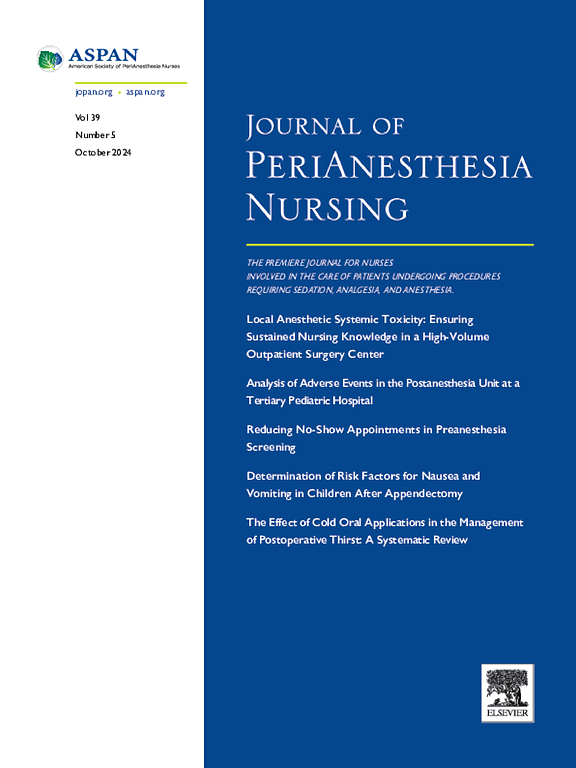盐酸罗哌卡因联合艾氯胺酮胸腔椎旁阻滞对肺癌根治性手术患者疼痛及术后恢复的影响。
IF 2
4区 医学
Q2 NURSING
引用次数: 0
摘要
目的:探讨盐酸罗哌卡因联合艾氯胺酮应用椎旁阻滞(PVB)对择期胸腔镜肺癌根治性手术患者镇痛和促进术后恢复的疗效。设计:对70例择期胸腔镜肺癌根治性手术患者进行随机对照试验。方法:将受试者随机分为艾氯胺酮组(K组)和对照组(C组)。K组患者给予0.1 mg/kg艾氯胺酮和0.5%罗哌卡因联合治疗PVB,而C组患者仅给予0.5%罗哌卡因。患者从麻醉后护理病房出院至第一次按压镇痛泵的时间间隔及按压次数。监测患者不同时间点的平均动脉压、心率、血氧饱和度等参数;术前及术后6小时静脉血白细胞介素-6、肿瘤坏死因子-α、c反应蛋白水平;疼痛评估使用数字评定量表得分。结果:与C组相比,K组患者术后48小时内首次镇痛泵按压间隔时间明显延长,有效镇痛泵按压次数明显减少。结论:PVB联合盐酸罗哌卡因联合艾氯胺酮有效延长了胸腔镜肺癌根治性手术患者首次使用镇痛泵的时间,降低了镇痛泵的总需求量,促进了患者的快速恢复。本文章由计算机程序翻译,如有差异,请以英文原文为准。
Combination of Ropivacaine Hydrochloride and Esketamine for Thoracic Paravertebral Block on Pain and Postoperative Recovery of Patients Undergoing Radical Resection Surgery for Lung Cancer
Purpose
This study aims to investigate the efficacy of a combination of ropivacaine hydrochloride and esketamine in paravertebral block (PVB), in providing analgesia and promoting the postoperative recovery of patients undergoing elective thoracoscopic radical lung cancer surgery.
Design
A randomized controlled trial was conducted involving 70 patients scheduled for elective thoracoscopic radical lung cancer surgery.
Methods
Participants were randomly assigned to either the esketamine group (K group) or the control group (C group). Patients in the K group were administered a combination of 0.1 mg/kg of esketamine and 0.5% ropivacaine for PVB, while patients in the C group received only 0.5% ropivacaine. The time interval between the patient’s discharge from the postanesthesia care unit and the first press of the analgesic pump and the number of presses. Various parameters that were monitored included the patients’ mean arterial pressure, heart rate, and oxygen saturation at different time points; levels of interleukin-6, tumor necrosis factor-α, and C-reactive protein in venous blood preoperatively and 6 hours postoperatively; pain assessed using the numeric rating scale scores.
Findings
Compared with group C, patients in group K had significantly longer intervals before their first postoperative analgesic pump press and significantly fewer effective analgesic pump presses in the 48-hour postoperative period. Resting numeric rating scale scores were significantly lower in group K at 24 and 48 hours postoperatively (both P < .05). In terms of postoperative recovery, sedation score during extubation was lower in group K compared with group C (P < .05). Patients in group K had significantly improved quality of recovery on the third day postoperatively (both P < .05). The levels of interleukin-6, tumor necrosis factor-α, and C-reactive protein in venous blood were significantly lower in group K than in group C 24 hours postoperatively, and the difference was statistically significant (P < .05).
Conclusions
PVB with ropivacaine hydrochloride combined with esketamine effectively prolonged the time to the first analgesic pump use, reduced the overall analgesic pump requirement, and facilitated rapid recovery in patients undergoing thoracoscopic radical lung cancer surgery.
求助全文
通过发布文献求助,成功后即可免费获取论文全文。
去求助
来源期刊

Journal of Perianesthesia Nursing
NURSING-
CiteScore
2.20
自引率
17.60%
发文量
279
审稿时长
90 days
期刊介绍:
The Journal of PeriAnesthesia Nursing provides original, peer-reviewed research for a primary audience that includes nurses in perianesthesia settings, including ambulatory surgery, preadmission testing, postanesthesia care (Phases I and II), extended observation, and pain management. The Journal provides a forum for sharing professional knowledge and experience relating to management, ethics, legislation, research, and other aspects of perianesthesia nursing.
 求助内容:
求助内容: 应助结果提醒方式:
应助结果提醒方式:


